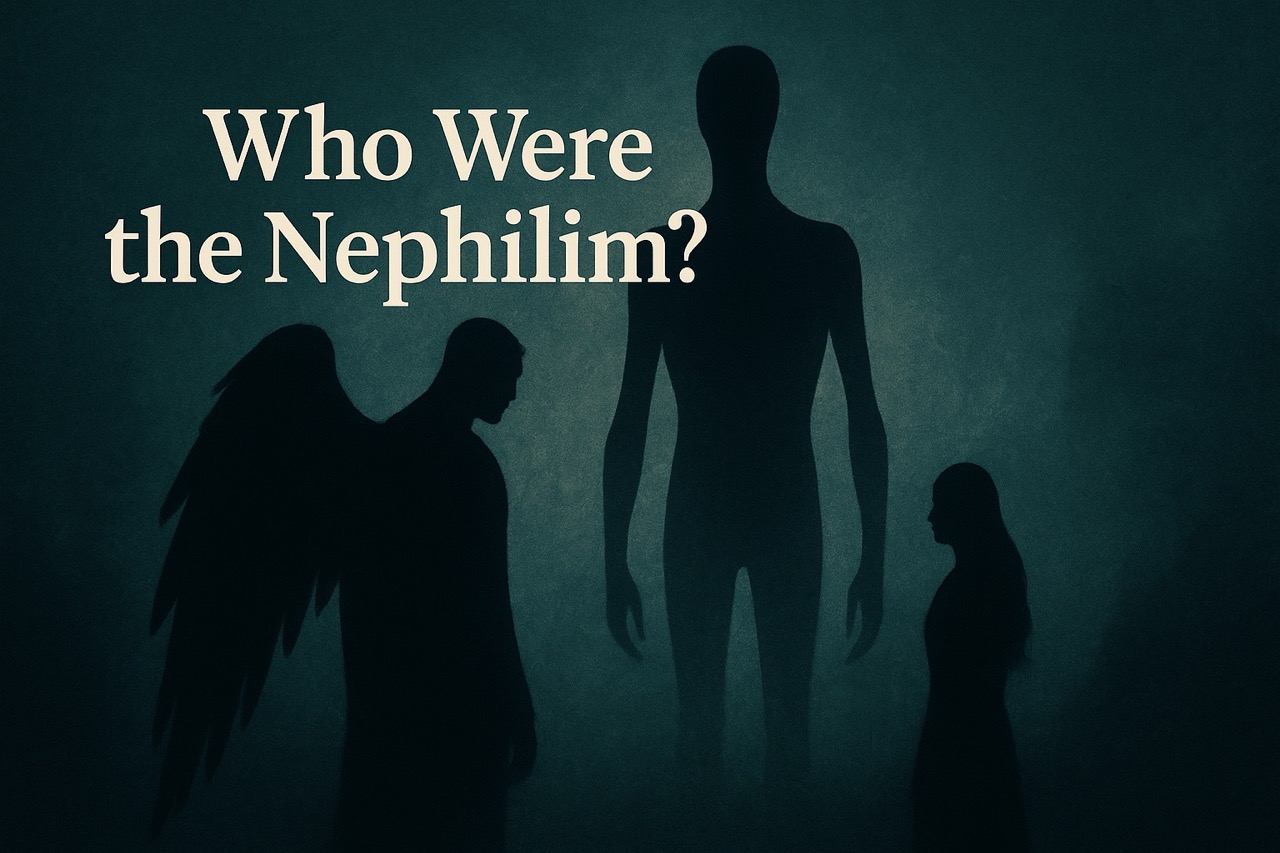The Nephilim were not just mythical giants. They were real, terrifying figures who appear in Scripture at one of the darkest turning points in human history. Long before Goliath, there were beings so powerful and unnatural that God sent a Flood to wipe them—and the corruption that created them—off the earth.
But who exactly were they? Where did they come from? And what if the story didn’t end with the Flood?
In this article, we explore biblical references, ancient Jewish writings, and archaeological theories that suggest the Nephilim were not only real—but foundational to understanding what Jesus meant when He warned, “As it was in the days of Noah, so will it be at the coming of the Son of Man” (Matthew 24:37).
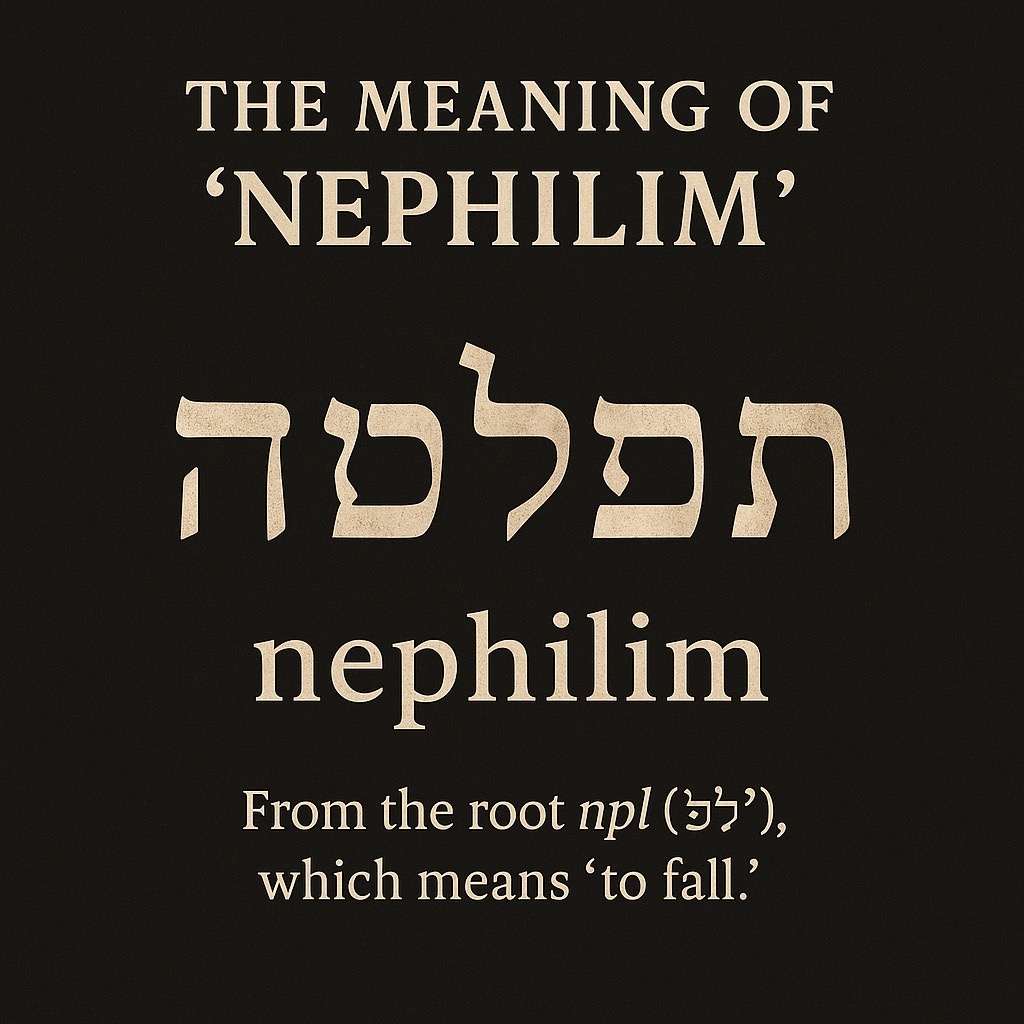
The Meaning of “Nephilim”
The Hebrew word Nephilim comes from the root npl (נָפַל), which means “to fall.” This is why they are often called “the fallen ones.” Some interpret this as referring to their angelic fathers—the rebellious “sons of God”—while others believe it describes the nature of the offspring themselves: beings fallen from the created order.
In Genesis 6:4 (ESV), we read:
“The Nephilim were on the earth in those days, and also afterward, when the sons of God came in to the daughters of man and they bore children to them. These were the mighty men who were of old, the men of renown.”
The term appears only a few times in the Bible, but its impact is massive. The Book of Numbers references the Nephilim again when Israelite spies report seeing giants in Canaan:
“And there we saw the Nephilim (the sons of Anak, who come from the Nephilim), and we seemed to ourselves like grasshoppers, and so we seemed to them.” (Numbers 13:33)
This description highlights their immense size and fearsome nature—a terror so great it crippled Israel’s faith.

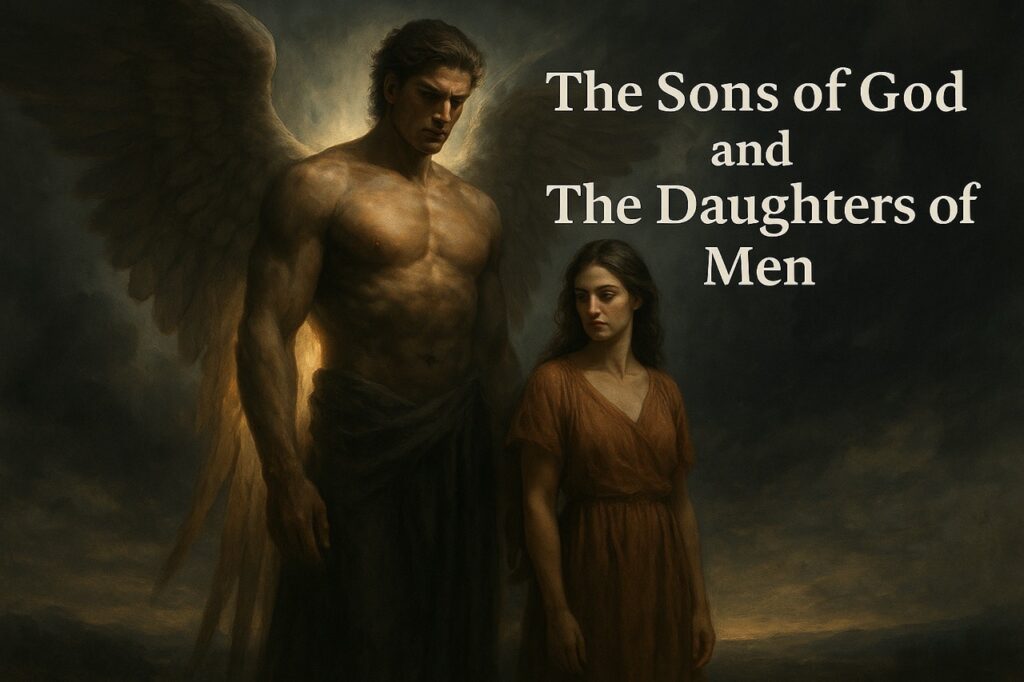
The Sons of God and the Daughters of Men
Genesis 6:1–2 sets the mysterious stage for one of the Bible’s most controversial events—the birth of the Nephilim:
“When man began to multiply on the face of the land and daughters were born to them, the sons of God saw that the daughters of man were attractive. And they took as their wives any they chose.” — Genesis 6:1–2 (ESV)
This passage introduces the strange union that produced the Nephilim—a hybrid race that became the catalyst for God’s worldwide judgment by the Flood. But the question remains: Who were the “sons of God”? And why did their offspring become giants, warriors, and “men of renown”?
Angelic View (The Original and Ancient Understanding)
The earliest and most widely held interpretation, known as the Angelic View, understands the “sons of God” (Hebrew: bene ha’elohim) as fallen angels who took on human form or possessed human hosts in order to marry and impregnate mortal women. This view is supported by:
- The Book of Enoch – An ancient Jewish text widely read in the Second Temple period, which provides a detailed account of 200 Watcher angels descending to Mount Hermon and taking wives. Their children became the Nephilim—enormous giants who corrupted the earth (1 Enoch 6–7).
- Early Church Fathers – Theologians like Justin Martyr, Athenagoras, Irenaeus, Tertullian, and Origen upheld this view, believing these angelic unions produced demonic offspring who were judged at the Flood.
- Biblical Word Usage – The term bene ha’elohim is used elsewhere in the Old Testament (e.g., Job 1:6, Job 2:1, Job 38:7) exclusively to describe supernatural beings or angels—not human descendants.
- New Testament References – 2 Peter 2:4 and Jude 6 describe angels who “did not stay within their proper dwelling” and were punished by God, strongly echoing the Genesis 6 narrative.
This view provides a coherent and supernatural framework for understanding why the Nephilim were not just morally corrupt—but genetically unnatural. It also explains why their presence led to such swift and severe judgment.
Sethite View (Later Church Tradition)
The Sethite View, first advanced by Julius Africanus and made popular by St. Augustine in the 5th century, interprets the sons of God as descendants of Seth, the righteous son of Adam. The daughters of men, in this view, are seen as descendants of Cain, the wicked lineage.
Proponents argue that this is a symbolic account of intermarriage between the godly and ungodly, leading to moral corruption. However, there are major challenges:
- Linguistically, “sons of God” never refers to Seth’s line elsewhere in the Bible.
- The result of these unions—giant hybrid beings—is hard to reconcile with normal human lineage.
- The judgment that follows is global and cosmic in scale, suggesting a transgression beyond simple intermarriage.
While this view became the dominant interpretation in Catholic and Reformation theology, many modern scholars now acknowledge it was a theological reaction to the supernatural view, rather than a faithful reading of the original Hebrew context.
Royalty or Tyrant-Kings View
A third, less common interpretation is the Royalty View, which suggests the “sons of God” were powerful kings or rulers who acted as divine figures on earth, taking women by force. Some point to ancient Near Eastern cultures where kings were considered sons of the gods, and took harems as symbols of their power.
While this view acknowledges the potential abuse of power and corruption, it still fails to account for the Nephilim’s unnatural traits—namely, their giant stature, warlike nature, and supernatural legacy across cultures.
Why the Angelic View Aligns Best with Scripture
Among the three, the Angelic View is the most consistent with biblical language, ancient Jewish interpretation, and the severity of the Flood narrative. It also connects Genesis 6 directly to New Testament prophecy, particularly Jude’s warning that certain angels are “kept in eternal chains under gloomy darkness” for their sin—clearly referring to a unique rebellion.
Furthermore, this view aligns with the supernatural worldview of the Bible, where spiritual beings interact with humanity and sometimes cross forbidden boundaries. The result? Beings like the Nephilim—part human, part angelic, and wholly corrupt.
“These were the mighty men who were of old, the men of renown.” — Genesis 6:4
The phrase “men of renown” suggests a global memory—one echoed in mythologies of giants, demigods, and titanic heroes from cultures around the world. Could these be distorted memories of the same Nephilim described in Scripture?
Related Passages and Cross-References
- Job 1:6 / 38:7 – “sons of God” used clearly for angels.
- 2 Peter 2:4–5 – Fallen angels judged at the time of Noah.
- Jude 6–7 – Angels who abandoned their proper domain, connected to sexual immorality.
- Deuteronomy 3:11 – Og of Bashan, a giant Rephaim king, survives as a remnant.
- Numbers 13:33 – The Nephilim “and we were like grasshoppers in their sight.”
Summary: Who Were the “Sons of God”?
Their offspring—the Nephilim—were more than tall men. They were the product of forbidden unions and a major reason for the Flood.
Not Sethites. Not kings.
They were spiritual beings, heavenly rebels who committed a great offense.
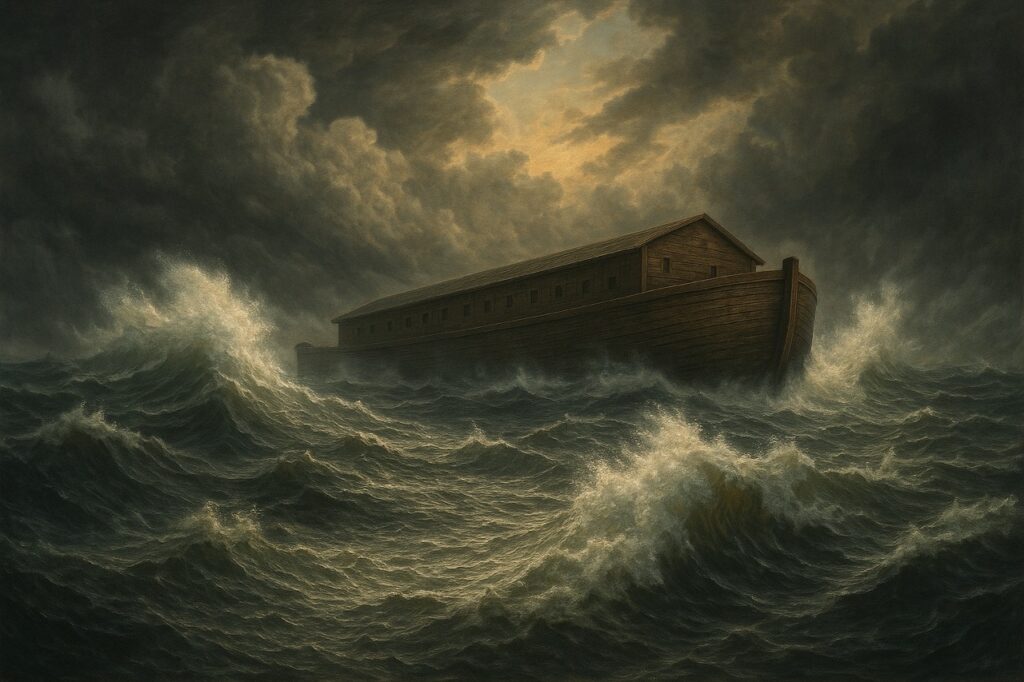
The Flood and the Nephilim’s Destruction
Genesis 6:5–7 reveals the heart of God in one of the most tragic turning points in human history:
“The LORD saw that the wickedness of man was great in the earth, and that every intention of the thoughts of his heart was only evil continually.
And the LORD regretted that he had made man on the earth, and it grieved him to his heart.
So the LORD said, ‘I will blot out man whom I have created from the face of the land…’” — Genesis 6:5–7 (ESV)
This was not mere divine anger — it was heartbreak. And it was more than human sin. Scripture tells us all flesh had corrupted its way on the earth (Genesis 6:12). Something deeper had taken root: a hybrid corruption, seeded by the unnatural union of the sons of God and the daughters of men (Genesis 6:1–4). Their offspring — the Nephilim — represented a breach of creation so severe that only a reset could restore what God had made.
Why Did God Send the Flood?
The traditional view of the Flood as punishment for human wickedness is accurate — but incomplete. The story of the Nephilim adds an essential dimension: God was not just judging moral failure. He was confronting a cosmic contamination.
- Spiritual rebellion: The “sons of God” (interpreted in the angelic view as fallen angels) violated the boundaries between heaven and earth.
- Genetic corruption: The offspring of these unions were the Nephilim — beings not meant to exist, possibly distorting the image of God in man.
- Cultural collapse: Ancient sources, including the Book of Enoch, describe the Nephilim as introducing humanity to bloodshed, enchantments, weaponry, sorcery, and occult knowledge (1 Enoch 7–8).
“They devoured all which the labor of men produced… until men were unable to sustain them. Then the giants turned against them and devoured mankind.” — 1 Enoch 7:3–5
In other words, the Nephilim were not just big — they were dangerous. Their presence accelerated depravity, deified violence, and disrupted creation. God’s judgment was not arbitrary wrath — it was a surgical strike to prevent irreversible corruption of humanity and the earth itself.
A Cleansing, Not Just a Catastrophe
The Flood was not merely punishment — it was preservation.
Noah is introduced in Genesis 6:9 as “blameless in his generations” — a phrase some interpret as not only moral righteousness but genetic integrity, untainted by Nephilim bloodlines. His selection was part of protecting the purity of the human race, and through it, preserving the future arrival of the Messiah (Luke 3:36 traces Christ’s lineage through Noah).
Every element of the Flood narrative speaks to totality:
- “All flesh had corrupted their way…” (Genesis 6:12)
- “The end of all flesh is come before me…” (Genesis 6:13)
- “…to destroy from under heaven all flesh…” (Genesis 6:17)
This wasn’t overreaction — it was divine mercy. By removing the Nephilim and stopping the escalation of spiritual contamination, God safeguarded the promise of redemption.
Did the Nephilim Trigger the Flood?
In many ancient Jewish sources — especially 1 Enoch and the Book of Jubilees — the Nephilim are explicitly blamed as the final tipping point. Their bloodthirsty rule and unnatural origins made the pre-Flood world unrecognizable. These texts expand Genesis 6:1–4, portraying the Watchers (fallen angels) as the instigators and the Nephilim as the fruit of their rebellion.
- 1 Enoch 10:9–10 – God instructs the angels to destroy the giants because they have filled the earth with violence and corrupted mankind.
- 1 Enoch 15–16 – Declares the spirits of dead Nephilim become evil spirits (demons), roaming the earth in unrest.
- Jubilees 5:2–3 – States that “the sons of God saw the daughters of men… and they bore children… giants… and the whole earth was filled with sin and violence.”
These accounts, while not canonical, reflect how early Jewish and Christian thinkers understood the Flood: not just as a reset of human sinfulness, but as a divine purge of something unnatural — a contamination that could not be allowed to spread.
The Flood as Cosmic Reset
Seen through this lens, the Flood becomes the first eschatological judgment — a foreshadowing of the final judgment at the end of the age. It draws a parallel with Jesus’ warning in Matthew 24:37:
“As it was in the days of Noah, so will it be at the coming of the Son of Man.”
Just as the first judgment removed a corrupted hybrid civilization, the final one will judge a world again filled with violence, deception, and rebellion.
The Nephilim were wiped out… but their legacy wasn’t entirely buried. Their return — or something like it — is hinted at in later biblical texts and modern prophetic theories. And that’s the subject of the next section.
Summary: The Nephilim and the Flood
- Who were the Nephilim? They were the hybrid offspring of fallen angels and human women.
- Why did God send the Flood? Because the corruption of humanity — physically, morally, and spiritually — had reached an irreversible tipping point.
- What was the Flood really about? It was the destruction of the Nephilim, a divine act of mercy to reset creation and preserve the human bloodline.
This wasn’t just a story about rain. It was a war to protect the future of mankind.
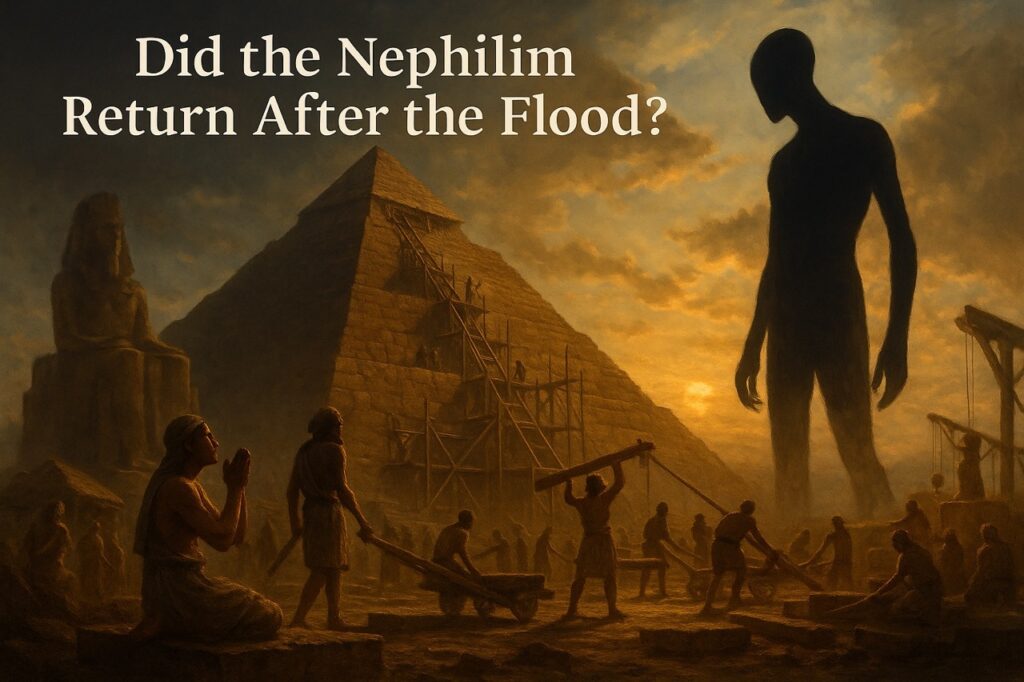
Did the Nephilim Return After the Flood?
Genesis 6:4 contains a chilling and often overlooked phrase:
“The Nephilim were on the earth in those days — and also afterward…”
— Genesis 6:4 (ESV)
This “also afterward” raises profound theological questions. If the Flood was meant to wipe out the Nephilim — why do we see giants reappear later in the biblical narrative? Were they reborn? Recreated? Or did something — or someone — survive?
Possibility 1: More Angelic Incursions After the Flood
One interpretation is that additional incursions occurred after the Flood, where fallen angels once again defied God’s boundaries. This is supported by traditions found in 1 Enoch and Jubilees, which suggest multiple waves of rebellion.
While Scripture doesn’t describe another Genesis 6-style event explicitly, some scholars believe that the emergence of giant clans in Canaan may point to repeated interventions by spiritual beings who continued corrupting humanity.
This theory explains how the same pattern of giants, violence, and idolatry resurfaces — especially in regions deeply associated with demonic worship and child sacrifice (e.g., the land of Canaan and Molech cults).
Possibility 2: Nephilim Genes Survived the Flood
Another theory holds that the genetic material of the Nephilim survived through the wives on the Ark, most commonly proposed through Ham’s wife.
While Noah was described as “blameless in his generations” (Genesis 6:9) — possibly implying physical purity — nothing is said about the genetic lineage of his sons’ wives. If even one bore Nephilim DNA, that seed could have passed into post-Flood populations.
Supporters of this view point to the rapid reappearance of giant tribes in the generations that followed:
- Anakim — towering warriors seen by the Israelite spies in Numbers 13.
- Rephaim — mentioned repeatedly in Deuteronomy and Joshua.
- Emim and Zamzummim — formidable ancient people groups in Canaan.
- Og of Bashan — a king whose iron bed measured over 13 feet long (Deuteronomy 3:11).
These were not just metaphorical giants. Their physical descriptions — and the terror they inspired — are consistently treated as literal and fearsome realities.
Possibility 3: Spiritual Revival, Not Biological Survival
A third view interprets “also afterward” as a spiritual repetition of the Nephilim pattern — not a direct genetic line.
In this interpretation, the “Nephilim” concept becomes symbolic of demonic influence, spiritual corruption, and tyrannical power. Just as the sons of God corrupted humanity pre-Flood, so too could demonic forces corrupt kings, cultures, and bloodlines again. These new “giants” may not have been physical hybrids, but men spiritually aligned with the Watchers’ rebellion — channeling the same darkness.
Still, this doesn’t explain the specificity of measurements like Og’s bed, or the repeated references to physical stature, which makes many scholars favor a literal hybrid or biological remnant theory.
Scriptural Clues That Giants Returned
The strongest biblical support for a Nephilim return comes from the spy report in Numbers 13:33:
“There we saw the Nephilim (the sons of Anak, who come from the Nephilim), and we seemed to ourselves like grasshoppers, and so we seemed to them.”
This verse directly names the Anakim as descendants of the Nephilim — confirming either survival or a second incursion.
Other references include:
- Deuteronomy 2:10-11 – The Emim and Rephaim are described as giants.
- Joshua 12:4 – Describes Og of Bashan as the last of the Rephaim.
- 2 Samuel 21:16–22 – Lists multiple Philistine giants, descendants of a giant from Gath (Goliath’s hometown).
- 1 Chronicles 20:4–8 – Echoes the same line of giants — some with six fingers and toes (a genetic marker often cited in hybrid theories).
These post-Flood giants were concentrated in Canaan, the very land God commanded Israel to reclaim — not just for territory, but to purge it of the corruption that echoed the pre-Flood world.
Did the Nephilim Really Return?
Whether through direct bloodline, repeated angelic rebellion, or spiritual mimicry, the Nephilim narrative clearly didn’t end with the Flood.
Ancient giants opposed Israel, occupied sacred spaces, and entrenched themselves in pagan civilizations. Their reappearance seems intentional — not random. In fact, Israel’s conquest under Joshua can be seen as a second judgment against the Nephilim, cleansing the land once again.
And many believe we may see their return yet again in the final days — not necessarily as giants of flesh, but as a resurgence of the same spiritual forces that threatened the world in the days of Noah.
Summary: Could the Nephilim Have Returned?
- Genesis 6:4 hints that their presence extended beyond the Flood.
- Giant clans like the Anakim and Rephaim point to their survival or revival.
- Three main views exist: repeated angelic rebellion, genetic survival through the Ark, or spiritual reemergence of Nephilim-like wickedness.
- Scripture connects the Anakim to the Nephilim directly — especially in Numbers 13:33.
The Nephilim may have been purged once…
But their story — and possibly their influence — is far from over.

Why the Nephilim Still Matter Today
Jesus didn’t speak casually when He said:
“As it was in the days of Noah, so will it be at the coming of the Son of Man.”
— Matthew 24:37 (ESV)
This one sentence holds layers of prophetic weight. It’s not just a passing reference to Noah’s story—it’s a warning. A signal that what happened before the Flood will echo again before Christ returns.
But what exactly defined the days of Noah?
1. Unrestrained Violence and Corruption
Genesis 6:11 tells us:
“Now the earth was corrupt in God’s sight, and the earth was filled with violence.”
This wasn’t just human aggression. It was systemic, widespread, and likely fueled by demonic influence. The Nephilim—offspring of spiritual rebellion—are described as mighty, violent warriors. Ancient texts like the Book of Enoch say they taught humanity warfare, weapon-making, and bloodshed.
Sound familiar?
Today, global violence is celebrated in entertainment, mass destruction is mechanized, and warfare includes AI, autonomous drones, and bioweapons. The earth is again being filled with violence—both literal and spiritual.
2. Sexual Perversion and Boundary Breaking
Genesis 6:2 describes the sons of God taking human wives—crossing the created boundary between the spiritual and physical realms. This divine-human rebellion wasn’t just immoral… it was unnatural.
Today, we see increasing celebration of boundaryless identity, from gender ideology to “synthetic womb” tech, and even AI-driven relationships. Human identity, sexuality, and the family structure are being reshaped—outside of God’s original design.
Just like in Noah’s day, lines once called sacred are being erased.
3. Genetic and Spiritual Corruption
Genesis 6:12 says:
“All flesh had corrupted their way on the earth.”
The corruption wasn’t just spiritual—it may have been biological. The ancient Book of Enoch claims the Watchers taught humanity sorcery, astrology, and genetic manipulation, including mixing species. The Nephilim, according to these texts, were not only giants, but also consumed animals and humans, leading to the corruption of all flesh.
Today, we’re seeing eerie parallels:
- CRISPR and gene-editing technologies pushing past natural boundaries.
- Human-animal hybrids being engineered in labs.
- Transhumanist thinkers openly advocating for a post-human future.
- AI-controlled bodies and neural implants blurring what it means to be human.
Even mainstream headlines question what constitutes “life” or “consciousness.” We are reawakening the themes of the pre-Flood world: hubris, hybridization, and rebellion against the Creator.
4. The Rise of the Alien/UFO Narrative
Many researchers now suggest that modern UAP phenomena may be a rebranding of ancient spiritual realities. Could what we call “aliens” be Nephilim-like beings, or fallen angelic remnants masquerading under new names?
Biblically, the “principalities and powers” Paul warned about (Ephesians 6:12) haven’t disappeared. They’ve adapted—and possibly resurfaced. Ezekiel’s wheel, Daniel’s watchers, and Revelation’s beasts may all be part of a deeper cosmic reality now resurfacing.
The ancient deception may simply have changed language, not intent.
5. A Final Warning—and a Reminder of Hope
The Nephilim matter not because we’re obsessed with ancient giants, but because they mark the edge of God’s tolerance. Their rise preceded worldwide judgment.
They are a signpost of how far humanity had fallen—and how far we’re falling again.
Yet, just like before, God preserves a remnant:
“But Noah found favor in the eyes of the Lord.”
— Genesis 6:8
Noah didn’t survive because he was perfect. He survived because he walked with God (Genesis 6:9). The same is true for us. In a world again filling with darkness, corruption, and hybrid pride, God is still searching for those who walk with Him.
Why This Matters to You
If the Nephilim story is true—and Scripture says it is—then it’s not just ancient history. It’s a prophetic mirror.
Are we living in the days of Noah… again?
- Are we seeing spiritual rebellion dressed as science?
- Genetic manipulation disguised as progress?
- Alien visitations as modern Watcher narratives?
- A world system trying to blend heaven, earth, and hell?
The return of Jesus will come at a time of similar chaos, perversion, and spiritual crossing of boundaries. But those who walk with Him—like Noah—will be carried through the judgment into redemption.
🔍 Related Reading from Paranoid Prophet
- What Really Happened in Genesis 6?
Dive deeper into the mysterious origins of the Nephilim, the sons of God, and the corrupted pre-Flood world. This foundational article breaks down the Hebrew terms and prophetic warnings embedded in Genesis 6. - Ezekiel’s Wheel and the UAP Connection
Explore how ancient visions and angelic beings might connect to modern UFO phenomena and the spiritual powers behind the Nephilim narrative. - Genesis, Creation, and Time Perception
Reconsider how time may have flowed differently in the early chapters of Genesis, and how that impacts our understanding of pre-Flood events. - Who Is God? Understanding His Nature Through Judgment and Mercy
Understand the heart of God behind the Flood — why He judged the Nephilim era and yet preserved a remnant through Noah.
🌐 External Resources
- Who Are the Nephilim? – Biblical Archaeology Society
An in-depth analysis of the Nephilim, exploring their origins, meanings, and the biblical passages that reference them. This article delves into the complexities surrounding these enigmatic figures. - Giants in the Land: A Biblical Theology of the Nephilim, Anakim, Rephaim, and Goliath – Knowing Scripture
This resource examines the biblical accounts of giants, their theological implications, and how they relate to the Nephilim narrative, providing a comprehensive theological perspective. - Q&A: How Did the Nephilim Reappear after the Flood? – Reasons to Believe
Astrophysicist Hugh Ross addresses the perplexing question of the Nephilim’s post-Flood existence, offering insights into possible explanations grounded in biblical texts. - The Book of Enoch – Wikipedia
An overview of the Book of Enoch, an ancient Jewish apocalyptic text that expands upon the Genesis account, detailing the actions of the Watchers and the origins of the Nephilim. - Was Goliath One of the Nephilim? – GotQuestions.org
This article explores the possibility of Goliath being a descendant of the Nephilim, analyzing scriptural references and historical context to assess this claim. - Og, King of Bashan – The Gospel Coalition Canada
A detailed look at Og, a biblical figure described as a giant, examining archaeological findings and scriptural accounts to understand his significance in the Nephilim narrative. - The Book of Giants – Wikipedia
An exploration of the Book of Giants, a text associated with the Dead Sea Scrolls, which provides additional context to the Nephilim and their legendary exploits. - Genesis 6:4 Meaning – BibleRef.com
A verse-by-verse commentary on Genesis 6:4, offering interpretations and theological insights into the mention of the Nephilim and the “sons of God.” - The Book of Enoch Explained: Fallen Watchers & Nephilim – YouTube
A visual and auditory exploration of the Book of Enoch, detailing the story of the Watchers and their offspring, the Nephilim, providing a comprehensive understanding through multimedia.
📖 Biblical Origins & Definitions
What does the word “Nephilim” mean?
The term Nephilim is derived from the Hebrew root npl, meaning “to fall.” Thus, it’s often interpreted as “fallen ones.” While some translations render it as “giants,” the exact meaning remains a topic of scholarly debate. Wikipedia
Who were the “sons of God” and “daughters of men” in Genesis 6?
Interpretations vary:
- Angelic View: Suggests that “sons of God” were fallen angels who took human wives, leading to the birth of the Nephilim.
- Sethite View: Posits that “sons of God” were descendants of Seth (the godly line), and “daughters of men” were descendants of Cain (the ungodly line). GotQuestions.org
How many times are the Nephilim mentioned in the Bible?
The term “Nephilim” appears explicitly in two passages:
- Genesis 6:4
- Numbers 13:33
📚 Ancient Texts & Interpretations
What does the Book of Enoch say about the Nephilim?
The Book of Enoch expands on Genesis 6, describing the Watchers—fallen angels who mated with human women, producing the Nephilim. These beings were giants who corrupted the earth, leading to the Great Flood. Clint Byars
Are the Watchers and the “sons of God” the same?
In the Book of Enoch, the Watchers are identified as the “sons of God” mentioned in Genesis 6. They are portrayed as angels who defied God by taking human wives and teaching forbidden knowledge. TheCollector+1GotQuestions.org+1
Is the Book of Enoch considered canonical?
The Book of Enoch is not part of the canonical scriptures for most Jewish and Christian traditions. However, it is regarded as canonical by the Ethiopian Orthodox Church and provides valuable insights into Second Temple Jewish thought. Wikipedia+1TheCollector+1
🦴 Physical Characteristics & Legacy
Were the Nephilim giants?
Yes, the Nephilim are often described as giants. For instance, Numbers 13:33 mentions that the Israelites felt like grasshoppers compared to them.
How tall were the Nephilim?
Specific heights aren’t provided in the Bible. However, apocryphal texts like the Book of Enoch describe them as exceptionally tall, with some interpretations suggesting they were several hundred feet tall—a figure likely symbolic to emphasize their might.
Did the Nephilim survive the Flood?
Genesis 6:4 notes that the Nephilim were on the earth “in those days—and also afterward.” This has led to various theories:
- Some believe that fallen angels continued to produce Nephilim post-Flood.
- Others suggest that Nephilim genes were carried on the Ark through Noah’s family. Answers in Genesis+2Crosswalk+2GotQuestions.org+2
🧬 Theological Implications & Modern Connections
Why did God destroy the Nephilim?
The Nephilim, born from the union of angels and humans, were seen as a corruption of God’s creation. Their existence and the widespread wickedness they brought were significant factors leading to the Great Flood.
Are demons the spirits of dead Nephilim?
Some traditions, based on texts like the Book of Enoch, suggest that demons are the disembodied spirits of the Nephilim, doomed to wander the earth after their physical forms were destroyed. GotQuestions.org
Could the Nephilim return in modern times?
While the Bible doesn’t explicitly state this, some interpretations of end-times prophecies and modern phenomena (like alleged alien encounters) speculate about a possible return or resurgence of Nephilim-like beings.
🌍 Cultural Parallels & Mythologies
Are there parallels between the Nephilim and other mythological figures?
Yes, many cultures have legends of giants or demigods:
- Greek Mythology: Titans and demigods born from gods and humans.
- Mesopotamian Texts: The Apkallu, semi-divine sages.
- Hindu Traditions: Beings like the Asuras.
Do other ancient texts mention beings like the Nephilim?
Yes, texts like the Book of Giants, found among the Dead Sea Scrolls, discuss similar beings resulting from divine-human unions, emphasizing their destructive nature. Wikipedia
🧠 Interpretations & Debates
What is the Sethite view regarding the Nephilim?
The Sethite view posits that the “sons of God” were descendants of Seth (Adam’s son), and the “daughters of men” were descendants of Cain. Their intermarriage led to moral decline, symbolized by the Nephilim.
How does the angelic view differ?
The angelic view interprets the “sons of God” as fallen angels who took human wives, producing the Nephilim. This perspective emphasizes a supernatural origin for these beings. GotQuestions.org
Why is there debate over the Nephilim’s identity?
The ambiguity in the biblical text, combined with varying interpretations from ancient texts and traditions, has led to ongoing debates about the true nature and origin of the Nephilim.
This FAQ aims to provide a comprehensive understanding of the Nephilim, drawing from biblical texts, ancient writings, and scholarly interpretations. For further exploration, consider reading the Book of Enoch and related apocryphal literature.

